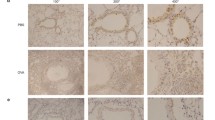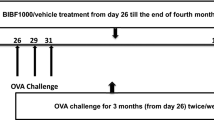Abstract
Background
The p38 mitogen-activated protein kinase (MAPK) appears to play an important role in various pathophysiological responses and has been suggested to be involved in many processes considered critical to the inflammatory response and tissue remodeling. Bronchial asthma is a chronic inflammatory disorder of the airway accompanied by increased vascular permeability. Vascular endothelial growth factor (VEGF) is a potent stimulator of bronchial inflammation, airway remodeling, and physiologic dysregulation that augments antigen sensitization and T-helper type 2 cell (Th2)-mediated inflammation in allergic airway diseases. However, there are little data on the relationship between p38 MAPK signaling and VEGF expression in allergic airway disease.
Objective
This study aimed to investigate the role of p38 MAPK on the pathogenesis of allergic airway disease, more specifically in VEGF expression.
Methods
Using ovalbumin (OVA)-inhaled mice and a selective p38 MAPK inhibitor, SB 239063, the involvement of p38 MAPK in allergen-induced VEGF expression in the airway was evaluated.
Results
The increases of phosphorylation of p38 MAPK, VEGF protein expression, and vascular permeability in the lung after OVA inhalation were decreased substantially by the administration of SB 239063. In addition, SB 239063 significantly reduced the increase of Th2 cytokines and OVA-specific IgE. The inhibition of p38 MAPK or VEGF signaling prevented and also decreased the increases in the number of inflammatory cells and airway hyperresponsiveness in OVA-induced allergic airway disease.
Conclusions
These results indicate that inhibition of p38 MAPK may attenuate allergen-induced airway inflammation and vascular leakage through modulation of VEGF expression in mice.










Similar content being viewed by others
References
Chetta A, Zanini A, Foresi A, Del Donno M, Castagnaro A, D’Ippolito R, et al. Vascular component of airway remodeling in asthma is reduced by high dose of fluticasone. Am J Respir Crit Care Med. 2003;167:751–7.
Bousquet J, Jeffery PK, Busse WW, Johnson M, Vignola AM. Asthma. From bronchoconstriction to airways inflammation and remodeling. Am J Respir Crit Care Med. 2000;61:1720–45.
Wilson J. The bronchial microcirculation in asthma. Clin Exp Allergy. 2000;30:51–3.
Dvorak HF, Brown LF, Detmar M, Dvorak AM. Vascular permeability factor/vascular endothelial growth factor, microvascular hyperpermeability, and angiogenesis. Am J Pathol. 1995;146:1029–39.
Lee KS, Kim SR, Park SJ, Lee HK, Park HS, Min KH, et al. Phosphatase and tensin homolog deleted on chromosome 10 (PTEN) reduces vascular endothelial growth factor expression in allergen-induced airway inflammation. Mol Pharmacol. 2006;69:1829–39.
Lee CG, Link H, Baluk P, Homer RJ, Chapoval S, Bhandari V, et al. Vascular endothelial growth factor (VEGF) induces remodeling and enhances TH2-mediated sensitization and inflammation in the lung. Nat Med. 2004;10:1095–103.
Asai K, Kanazawa H, Otani K, Shiraishi S, Hirata K, Yoshikawa J. Imbalance between vascular endothelial growth factor and endostatin levels in induced sputum from asthmatic subjects. J Allergy Clin Immunol. 2002;110:571–5.
Lee KS, Kim SR, Park HS, Jin GY, Lee YC. Cysteinyl leukotriene receptor antagonist regulates vascular permeability by reducing vascular endothelial growth factor expression. J Allergy Clin Immunol. 2004;114:1093–9.
Schaeffer HJ, Weber MJ. Mitogen-activated protein kinases: specific messages from ubiquitous messengers. Mol Cell Biol. 1999;19:2435–44.
Griswold DE, Young PR. Pharmacology of cytokine suppressive anti-inflammatory drug binding protein (CSBP), a novel stress-induced kinase. Pharmacol Commun. 1996;7:323–9.
Barnes PJ, Chung KF, Page CP. Inflammatory mediators of asthma: An update. Pharmacol Rev. 1998;50:515–96.
Kumar A, Lnu S, Malya R, Barron D, Moore J, Corry DB, et al. Mechanical stretch activates nuclear factor-kappaB, activator protein-1, and mitogen-activated protein kinases in lung parenchyma: implications in asthma. FASEB J. 2003;17:1800–11.
Taube C, Nick JA, Siegmund B, Duez C, Takeda K, Rha YH, et al. Inhibition of early airway neutrophilia does not affect development of airway hyperresponsiveness. Am J Respir Cell Mol Biol. 2004;30:837–43.
Underwood DC, Osborn RR, Kotzer CJ, Adams JL, Lee JC, Webb EF, et al. SB 239063, a potent p38 MAP kinase inhbitor, reduces inflammatory cytokine production, airways eosinophil infiltration, and persistence. J Pharmacol Exp Ther. 2000;293:281–8.
Duan W, Chan JH, McKay K, Crosby JR, Choo HH, Leung BP, et al. Inhaled p38a mitogen activated protein kinase antisense oligonucleotide attenuates asthma in mice. Am J Respir Crit Care Med. 2005;171:571–8.
Foltz IN, Lee JC, Young PR, Schrader JW. Hemopoietic growth factors with the exception of interleukin-4 activate the p38 mitogen-activated protein kinase pathway. J Biol Chem. 1997;27:3296–301.
Kwak YG, Song CH, Yi HK, Hwang PH, Kim JS, Lee KS, et al. Involvement of PTEN in airway hyperresponsiveness and inflammation in bronchial asthma. J Clin Invest. 2003;111:1083–92.
Chomczynski P, Sacchi N. Single-step method of RNA isolation by acid guanidium thiocyanate-phenol-chloroform extraction. Anal Biochem. 1987;162:156–9.
Livak KJ, Schmittgen TD. Analysis of relative gene expression data using real-time quantitative PCR and the 2(−Delta Delta C(T)) Method. Methods. 2001;25:402–8.
Tournoy KG, Kips JC, Schou C, Pauwels RA. Airway eosinophilia is not a requirement for allergen-induced airway hyperresponsiveness. Clin Exp Allergy. 2000;30:79–85.
Takeda K, Hamelmann E, Joetham A, Shultz LD, Larsen GL, Irvin CG, et al. Development of eosinophilic airway inflammation and airway hyperresponsiveness in mast cell-deficient mice. J Exp Med. 1997;186:449–54.
Wong WF. Inhibitors of the tyrosine kinase signaling cascade for asthma. Curr Opin Pharmacol. 2005;5:264–71.
Lee JC, Kumar S, Griswold DE, Underwood DC, Votta BJ, Adams JL. Inhibition of p38 MAP kinase as a therapeutic strategy. Immunopharmacology. 2000;47:185–201.
Howard MO, Schwartz LW, Newton JF, Qualls Jr CW, Yodis LA, Ventre JR. Comparative biochemical and morphometric changes associated with induction of the hepatic mixed function oxidase system in the rat. Toxicol Pathol. 1991;19:115–22.
Adams JL, Boehm JC, Kassis S, Gorycki PD, Webb EF, Hall R, et al. Pyrimidinylimidazole inhibitors of CSBP/p38 kinase demonstrating decreased inhibition of hepatic cytochrome P450 enzymes. Bioorg Med Chem Lett. 1998;8:3111–6.
Laufer SA, Wagner GK, Kotschenreuther DA, Albrecht W. Novel substituted pyridinyl imidazoles as potent anticytokine agents with low activity against hepatic cytochrome P450 enzymes. J Med Chem. 2003;46:3230–44.
Barone FC, Irving EA, Ray AM, Lee JC, Kassis S, Kumar S, et al. SB 239063, a second-generation p38 mitogen-activated protein kinase inhibitor, reduces brain injury and neurological deficits in cerebral focal ischemia. J Pharmacol Exp Ther. 2001;296:312–21.
Marshall LA, Hansbury MJ, Bolognese BJ, Gum RJ, Young PR, Mayer RJ. Inhibitors of the p38 mitogen-activated kinase modulate IL-4 induction of low affinity IgE receptor (CD23) in human monocytes. J Immunol. 1998;161:6005–13.
Bracke M, Coffer PJ, Lammers JW, Koenderman L. Analysis of signal transduction pathways regulating cytokine-mediated Fc receptor activation on human eosinophils. J Immunol. 1998;161:6768–74.
Takahashi H, Shibuya M. The vascular endothelial growth factor (VEGF)/VEGF receptor system and its role under physiological and pathological conditions. Clin Sci (Lond). 2005;109:227–41.
Issbrücker K, Marti HH, Hippenstiel S, Springmann G, Voswinckel R, Gaumann A, et al. p38 MAP kinase-a molecular switch between VEGF-induced angiogenesis and vascular hyperpermeability. FASEB J. 2003;17:262–4.
Kevil CG, Payne DK, Mire E, Alexander JS. Vascular permeability factor/vascular endothelial cell growth factor-mediated permeability occurs through disorganization of endothelial junctional proteins. J Biol Chem. 1998;273:15099–103.
Yoshino Y, Aoyagi M, Tamaki M, Duan L, Morimoto T, Ohno K. Activation of p38 MAPK and/or JNK contributes to increased levels of VEGF secretion in human malignant glioma cells. Int J Oncol. 2006;29:981–7.
Meng Q, Wang W, Fang C, Lv Z, Fan Y, An Y, et al. IL-25 and Its Receptor (IL-25R) in Allergic Inflammation: Its Role in VEGF-mediated Angiogenesis. J Allergy Clin Immunol. 2009;123:S58.
Nissim Ben Efraim AH, Puxeddu I, Eliashar R, Levi-Schaffer F. Hypoxia Modulates Human Eosinophils Signalling and Function. J Allergy Clin Immunol. 2009;123:S53.
Leigh R, Oyelusi W, Wiehler S, Koetzler R, Zaheer RS, Newton R, et al. Human rhinovirus infection enhances airway epithelial cell production of growth factors involved in airway remodeling. J Allergy Clin Immunol. 2008;121:1238–45.
Lee KS, Kim SR, Park SJ, Msin KH, Lee KY, Choe YH, et al. Mast cells can mediate vascular permeability through regulation of the PI3K-HIF-1alpha-VEGF axis. Am J Respir Crit Care Med. 2008;178:787–97.
Lee YC, Kwak YG, Song CH. Contribution of vascular endothelial growth factor to airway hyper-responsiveness and inflammation in a murine model of toluene diisocyanate-induced asthma. J Immunol. 2002;168:3595–600.
Horiuchi H, Weller PF. Expression of vascular endothelial growth factor by human eosinophils: upregulation by granulocyte macrophage colony stimulating factor and interleukin-5. Am J Respir Cell Mol Biol. 1997;17:70–7.
Taichman NS, Young S, Cruchley AT, Taylor P, Paleolog E. Human neutrophils secrete vascular endothelial growth factor. J Leukocyte boil. 1997;62:397–400.
Hoshino M, Nakamura Y, Hamid QA. Gene expression of vascular endothelial growth factor and its receptors and angiogenesis in bronchial asthma. J Allergy Clin Immunol. 2001;107:1034–8.
Acknowledgments
We thank Professor Mie-Jae Im (Chonbuk National University Medical School, Jeonju, South Korea) for critical readings of the manuscript. This work was supported by the Korea Healthcare Technology R&D Project, Ministry for Health and Welfare, Republic of Korea; Grant A084144 (to Yong Chul Lee) and Grant A111992 (to So Ri Kim).
Conflict of interest
The authors declare that they have no conflict of financial interests.
Author information
Authors and Affiliations
Corresponding author
Additional information
So Ri Kim and Kyung Sun Lee contributed equally to this work.
Electronic supplementary material
Below is the link to the electronic supplementary material.
ESM 1
(PDF 52 kb)
Rights and permissions
About this article
Cite this article
Kim, S.R., Lee, K.S., Park, S.J. et al. Inhibition of p38 MAPK Reduces Expression of Vascular Endothelial Growth Factor in Allergic Airway Disease. J Clin Immunol 32, 574–586 (2012). https://doi.org/10.1007/s10875-012-9672-5
Received:
Accepted:
Published:
Issue Date:
DOI: https://doi.org/10.1007/s10875-012-9672-5




